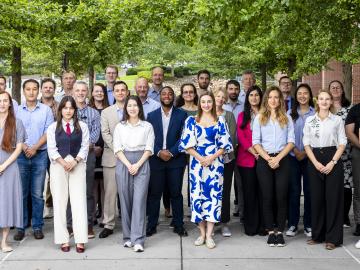
Filter News
Area of Research
- Biology and Environment (79)
- Biology and Soft Matter (1)
- Clean Energy (82)
- Climate and Environmental Systems (2)
- Computer Science (1)
- Fusion and Fission (7)
- Isotopes (2)
- Materials (49)
- Materials for Computing (9)
- National Security (15)
- Neutron Science (14)
- Sensors and Controls (1)
- Supercomputing (46)
News Type
News Topics
- (-) Composites (19)
- (-) Education (5)
- (-) Energy Storage (73)
- (-) Environment (141)
- (-) Frontier (42)
- (-) Polymers (20)
- (-) Security (24)
- 3-D Printing/Advanced Manufacturing (88)
- Advanced Reactors (19)
- Artificial Intelligence (85)
- Big Data (37)
- Bioenergy (74)
- Biology (82)
- Biomedical (48)
- Biotechnology (20)
- Buildings (38)
- Chemical Sciences (59)
- Clean Water (17)
- Climate Change (74)
- Computer Science (150)
- Coronavirus (34)
- Critical Materials (16)
- Cybersecurity (31)
- Decarbonization (67)
- Element Discovery (1)
- Emergency (2)
- Exascale Computing (41)
- Fossil Energy (5)
- Fusion (47)
- Grid (42)
- High-Performance Computing (79)
- Hydropower (5)
- Isotopes (49)
- ITER (4)
- Machine Learning (36)
- Materials (105)
- Materials Science (102)
- Mathematics (7)
- Mercury (9)
- Microelectronics (4)
- Microscopy (36)
- Molten Salt (4)
- Nanotechnology (42)
- National Security (65)
- Net Zero (11)
- Neutron Science (104)
- Nuclear Energy (83)
- Partnerships (50)
- Physics (55)
- Quantum Computing (33)
- Quantum Science (59)
- Renewable Energy (2)
- Simulation (43)
- Software (1)
- Space Exploration (15)
- Statistics (2)
- Summit (54)
- Sustainable Energy (78)
- Transformational Challenge Reactor (7)
- Transportation (52)
Media Contacts

The Oak Ridge Leadership Computing Facility welcomed users to an interactive meeting at the Department of Energy’s Oak Ridge National Laboratory from Sept. 10–11 for an opportunity to share achievements from the OLCF’s user programs and highlight requirements for the future.

U2opia Technology has licensed Situ and Heartbeat, a package of technologies from the Department of Energy’s Oak Ridge National Laboratory that offer a new method for advanced cybersecurity monitoring in real time.

Three flights, five thousand miles and half a dozen clearances and permissions stood between Tetiana Maltseva and the Department of Energy’s Oak Ridge National Laboratory. When she finally arrived at the lab to represent Ukraine at the 2024 Nuclear Energy Management School, her vision was clear.

A team led by scientists at ORNL identified and demonstrated a method to process a plant-based material called nanocellulose that reduced energy needs by a whopping 21%, using simulations on the lab’s supercomputers and follow-on analysis.

Nuclear physicists at the Department of Energy’s Oak Ridge National Laboratory recently used Frontier, the world’s most powerful supercomputer, to calculate the magnetic properties of calcium-48’s atomic nucleus.
Researchers at ORNL recently demonstrated an automated drone-inspection technology at EPB of Chattanooga that will allow utilities to more quickly and easily check remote power lines for malfunctions, catching problems before outages occur.

To speed the arrival of the next-generation solid-state batteries that will power electric vehicles and other technologies, scientists led by ORNL advanced the development of flexible, durable sheets of electrolytes. They used a polymer to create a strong yet springy thin film that binds electrolytic particles and at least doubles energy storage.

A study found that beaches with manmade fortifications recover more slowly from hurricanes than natural beaches, losing more sand and vegetation. The researchers used satellite images and light detection and ranging data, or LIDAR, to measure elevation changes and vegetation coverage. Changes in elevation showed how much sand was depleted during the storm and how much sand returned throughout the following year.

At ORNL, a group of scientists used neutron scattering techniques to investigate a relatively new functional material called a Weyl semimetal. These Weyl fermions move very quickly in a material and can carry electrical charge at room temperature. Scientists think that Weyl semimetals, if used in future electronics, could allow electricity to flow more efficiently and enable more energy-efficient computers and other electronic devices.

Seven entrepreneurs comprise the next cohort of Innovation Crossroads, a DOE Lab-Embedded Entrepreneurship Program node based at ORNL. The program provides energy-related startup founders from across the nation with access to ORNL’s unique scientific resources and capabilities, as well as connect them with experts, mentors and networks to accelerate their efforts to take their world-changing ideas to the marketplace.


